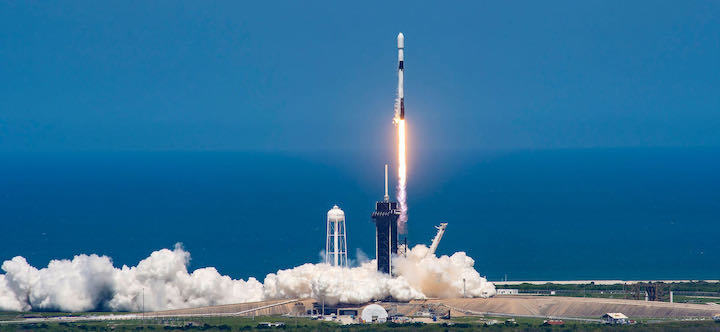6.05.2021

The oldest Falcon 9 booster in SpaceX’s operational rocket fleet sent 60 more Starlink internet satellites into space Tuesday with a launch from historic pad 39A at NASA’s Kennedy Space Center in Florida.
With the 60 satellites launched Tuesday, SpaceX has sent 1,565 Starlink spacecraft into orbit to beam broadband signals around the world, nearly nine times as many satellites in any other company’s constellation.
The 229-foot-tall (70-meter) Falcon 9 rocket climbed away from the Florida spaceport and rumbled through a sunny mid-afternoon sky, flying on a track northeast from the Kennedy Space Center to place 60 more Starlink broadband stations into orbit.
The mission began at 3:01 p.m. EDT (1901 GMT) Tuesday as nine kerosene-fueled Merlin 1D booster engines fired up to propel the 1.2-million-pound Falcon 9 launcher off the pad.
The Falcon 9 surpassed the speed of sound in about one minute, then shut down its first stage engines and released the booster about two-and-a-half minutes after liftoff.
The 15-story booster stage — designated B1049 in SpaceX’s fleet — continued coasting toward the high point of its suborbital trajectory and unfurled aerodynamic grid fins to help stabilize the rocket for descent back through the atmosphere.
Three of the booster’s Merlin engines reignited for an entry burn, and the rocket’s center engine ignited for a landing burn just before the first stage extended legs and settled onto the deck of SpaceX’s drone ship “Of Course I Still Love You” for a bullseye touchdown in the Atlantic Ocean.
The landing about eight-and-a-half minutes after liftoff punctuated the ninth trip to space and back for this booster, which debuted in September 2018. This reusable booster is the oldest operational first stage in SpaceX’s inventory, and its nine launches and landings ties another booster for the most number of flights in the Falcon 9 fleet.
SpaceX plans to return the drone ship and Falcon 9 booster to Port Canaveral, Florida, from the recovery area a few hundred miles east of Charleston, South Carolina. Ground crews at Cape Canaveral are expected to inspect and refurbish the rocket for a 10th flight.

The Falcon 9’s second stage engine completed two burns to place the 60 Starlink satellites into the proper orbit for deployment. About 64 minutes after liftoff, a forward-facing camera on the upper stage showed the 60 flat-panel satellites flying free of the rocket at an altitude of 182 miles (293 kilometers) south of New Zealand.
The 573-pound (260-kilogram) satellites will deploy their power-generating solar panels and switch on their krypton-fueled plasma thrusters to raise their altitude to 341 miles (550 kilometers) to join the rest of the Starlink fleet.
The launch Tuesday marked the 100th straight successful Falcon 9 or Falcon Heavy mission without an in-flight failure, a streak stretching back to June 2015. It was the 91st successful mission for SpaceX since a Falcon 9 rocket exploded during a pre-flight test at Cape Canaveral in September 2016, destroying the launch vehicle and an Israeli-owned communications satellite, and damaging SpaceX’s launch pad.
The Starlink satellites are built on SpaceX’s assembly line in Redmond, Washington.
The 1,565 Starlink satellites launched today include prototypes and failed spacecraft that have dropped out of orbit and burned up in the atmosphere. Jonathan McDowell, an astronomer and expert tracker of spaceflight activity, says more than 1,400 Starlink satellites are currently in orbit, not counting the 60 spacecraft launched Wednesday night.
The Federal Communications Commission has authorized SpaceX to deploy some 12,000 Starlink satellites operating at Ku-band, Ka-band, and V-band frequencies, and at a range of altitudes and inclinations in low Earth orbit. The satellites are already beaming low-latency, broadband signals to users who have signed up for Starlink beta testing.
So far, nearly all of the Starlink satellites launched by SpaceX operate in 341-mile-high orbits tilted at an inclination of 53 degrees to the equator.
“We do have global reach but we don’t have full connectivity globally,” said Gwynne Shotwell, SpaceX’s president and chief operating officer, at an industry conference last month. “We hope after about 28 launches, we’ll have continuous coverage throughout the globe. And then the plan after that is to continue to add satellites to provide additional capacity.”
The launch Tuesday was the 25th Falcon 9 flight dedicated to hauling operational Starlink satellites, known as Version 1.0, into orbit, and the 28th Falcon 9 mission overall with Starlink payloads on-board.
Last April, SpaceX requested approval from the FCC to operate its Starlink satellites at lower altitudes than initially planned, all between 335 miles (540 kilometers) and 354 miles (570 kilometers). The FCC approved the request last month.
With the commission’s approval, SpaceX will now operate its first 4,408 satellites at altitudes between 335 miles and 354 miles, instead of flying more than 2,800 of the spacecraft in orbits as high as 800 miles, or 1,300 kilometers, above Earth.
The FCC approval clears the way for SpaceX to start launching more Starlink satellites into polar orbit later this year. The polar orbiting satellites will give the Starlink network complete global coverage.
The updated Starlink network architecture has 1,584 satellites at 341 miles (550 kilometers) altitude and an inclination of 53 degrees, 1,584 satellites at 335 miles (540 kilometers) and an inclination of 53.2 degrees, 720 satellites at 354 miles (570 kilometers) and an inclination of 70 degrees, and 520 satellites at 348 miles (560 kilometers) and an inclination of 97.6 degrees.
SpaceX still has regulatory authorization to launch more than 7,000 additional Starlink satellites beyond the 4,408 spacecraft covered in the recent FCC approval.
The next Falcon 9 launch is scheduled for 2:42 a.m. EDT (0642 GMT) Sunday from pad 40 at Cape Canaveral Space Force Station, carrying the next batch of Starlink internet satellites.
Another Starlink mission is planned in mid-May with a Falcon 9 launch from pad 39A.
Quelle: SN
